|
Stein Collectors International, Inc. |
| An Article from 1897, provided by Ron Gray (This article first appeared in the June 2001 issue of Prosit) |
 |
ARTICLE ON BEER STEIN MARKERS FOUND
by Ronald E. Gray
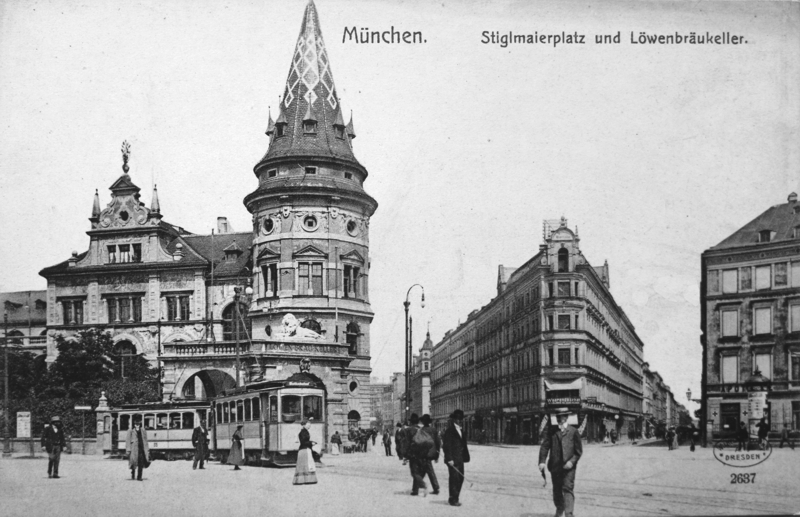
If you had your own stein at the beer hall, would you have been one to wonder how you were assured of getting your own stein back when it was refilled? At the Hofbräuhaus in Munich the steins are numbered. I even have the original receipt for my HB stein dated November 12, 1898, shortly after the article below was published. But what about the other beer halls (such as the Löwenbräukeller shown in the post card above) that might not number their steins? I found the answer on Ebay when I spotted an item described as "1897 Beer Markers Puppets for Steins Unusual!" The article below first appeared in The Strand Magazine in 1897. The Strand Magazine was founded by Georges Newnes (I presume the same one that provided the photos in the article) and published from 1891 to 1950. Maybe you remember it as the magazine that published the Sherlock Holmes stories. It will now be remembered as the magazine that gave us a new "go-with" collectible to seek for our beer steins. The article is quite interesting, but raises new questions. Did this fad die with the little old lady that knitted them? Who will be the first to discover one of these gems? Enjoy the article, I did.
Beer-Markers
by George Dollar
[Illustrations from Photos by George Newnes, Limited]
All roads in Germany lead to Munich, where the beer comes from, and all roads in Munich lead to the Löwenbräu Keller, where we got these beer-markers. The Keller is a noted place, possibly not so celebrated as the Hofbräuhaus, or Court Brewery, where the special brew of the Bavarian dignitaries is doled out in foamy quarts and pints to the populace; but in its own way it is unique. It is an enormous hall gaily decorated in evergreen, closely packed with tables, at which natives and visitors sit in loving communion over their "bock," while the band plays. The tunes are good, and the solid contentment of the crowd is sweet to look at; but the beer-markers, in the words of the poet, "take the bun."
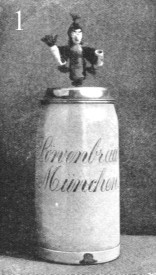 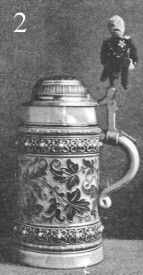 A Löwenbräu stein with the Münchner Kindl as beer marker, and a fancy stein with Caprivi perched on the thumblift. |
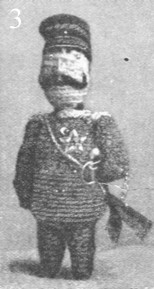 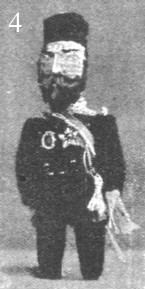 Kaiser Wilhelm of Germany, Emperor Nicholas of Russia |
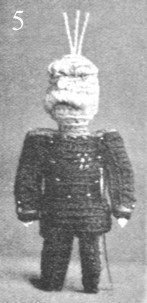 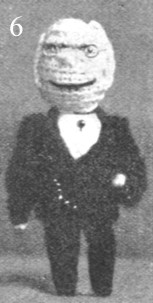 Bismarck (left) and German statesman Windthorst |
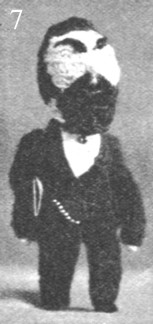 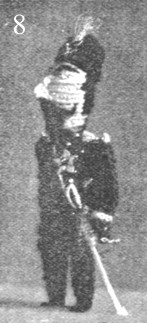 Eugene Richter, leader of the Reichstag, and Ferdinand of Bulgaria |
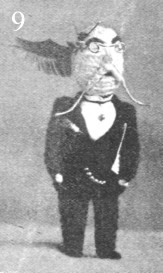
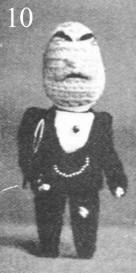 Dr. Sigl, editor of Vaterland, and Herr Ahlwardt |
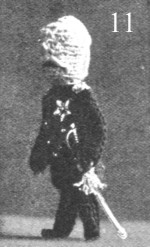 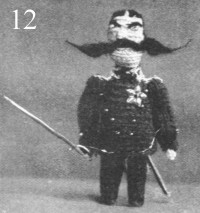 Caprivi, German Chancellor, and Lt. von Brüsewitz |
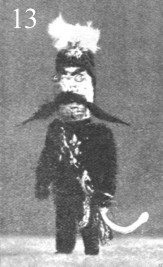 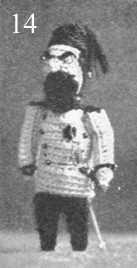 The Shah of Persia and Emin Pasha. |
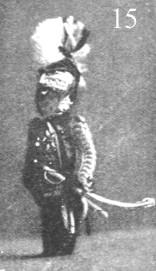 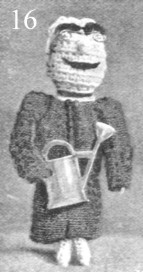 General Boulanger and Father Kneipp |
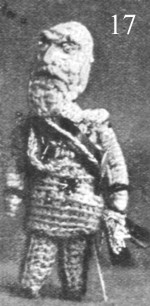 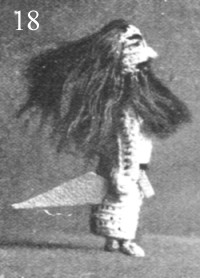 Luitpold, Regent of Bavaria, with Herr Tiefenbach (and his umbrella!) |
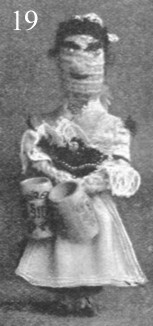 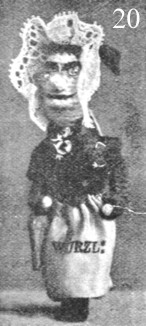 A Kellnerin with mugs in hand, and Wurzl, the vegetable lady |
To describe them briefly, they are little
puppets of knitted wool
about
four
inches high. Now, at the beginning of this article, you will find two
pictures
of beer-mugs, with the beer-markers stuck fast upon little metal knobs
at the
top of the handles. The markers are placed there by the beer-drinkers,
so that,
when the mug goes out to be refilled, it will come back to its proper
owner.
Each man, therefore, by simply placing his beer-marker upon his mug,
always gets
his own mug back, and not somebody else’s. The pretty Kellnerin,
or
waitress, is a very careful woman, but as all the mugs in the Löwenbräu
Keller
are alike, she might get them mixed up in the shuffle if the drinkers
did not
co-operate with her to make mistakes impossible.
The photographs reproduced on these pages will show the variety of
the
markers. They are nearly all caricatures of the prominent people of the
time, as
well as a few local figures, unknown to the great world – but about
them all
there is an excellent likeness to the originals.But let us to the
markers. First and foremost stands the Kaiser (3).
Note his
darting eye and his majestic air. A born ruler, with his manly breast
covered
with emblems – made of tin. His brown-yarn mustaches sweep across his
face as
if they wanted to kiss his ears while a faint tinge of red paint gives
colour to
his fat cheeks. The little figure is carefully made, and the Kaiser
grasps his
sword as if he were showing his troops the proper way to fight.
Beside the Kaiser, where the great difference between the Teuton and
Slavish
features may be seen, we place the Emperor of Russia (4). Now, very few
people
will believe us when we say that this is the Czar, but it
really is. The
likeness, however, is very poor. The Czar looks aged and distressed.
Possibly,
the knitter made him so on purpose, as a sly dig at the Czar’s late
hobnobbing
with la belle France.
We place Bismarck next (5). After him comes Windthorst (6), the
German
statesman
who died in 1891, and then Eugene Richter (7), the Radical leader of
the
Reichstag, or German House of Commons. When Bismarck was the first
figure in
Germany, his two greatest political enemies were Windthorst and
Richter. If
Bismarck wanted a canal dug or an army raised, his opponents were sure
to say
they weren’t needed, and at last the fight got so hot, that if Bismarck
had
asserted that the Atlantic Ocean was filled with water, the others
would have
said it was made of mud. Hence, we mention these nobilities together.
Note
Bismarck’s three hairs. They are all he has in the world, and the woman
who
knit the "Iron Chancellor" did not forget a single one. Mark also
Richter’s portfolio under his right arm, and his gold watch-chain. And
before
passing to Ferdinand, note Windthorst’s chubby face and expansive
mouth.
This (8) is Ferdinand of Bulgaria, whose little son, Prince Boris,
lately
stirred up a lot of excitement for his size, by being admitted to the
orthodox
faith. In all the caricatures of Ferdinand, you find him adorned with
an
enormous nose, and in this beer-marker the proboscis stands prominently
out.
There is nothing more to say about Ferdinand, except that his uniform
is made
out of blue wool. Indeed, all the beer-markers representing German
military men
are in blue. The editors and statesmen are in inky black.
Here (9) is an editor, with wise and knowing eyes, and a pen behind
his
ear.
Doubtless Dr. Sigl is unknown in England, but in Munich, where he edits
the
Catholic paper called the Fatherland, he is a noted public
character.
Sigl is a great opponent of progressive or Radical movements, and
advocates the
separation of Bavaria from the German Empire. His mustache shows true
editorial
training.
Herr Ahlwardt, the pompous and well-fed-looking individual who bears
down
upon us in (10), is a pugnacious anti-Semite who has figured
prominently in the
Reichstag. Once in a while he gets thrown into gaol on account of the
nasty way
he says things, and his popularity is as considerable as a
mustard-seed. Many of
his accusations against the Semites have been proved unfounded, and
this has not
added to his reputation. But he makes a jolly handsome beer-marker.
Our next reproduction shows Caprivi (11). We also see him upon the
fancy mug (2)
on the first page of this article. Caprivi succeeded Bismarck as
Chancellor, but
did not stay in power long. There was a dead set against his policy
from the
beginning, but during his short term of office he became noted
throughout the
Empire. This beer-marker is not half so effective as that of Lieutenant
von Brüsewitz
(12), who has lately set the tongue of Germany agog by killing a
civilian in a
duel. Brüsewitz is more or less of a military bully, and his opponent
is said
to have been guilty of no offence. Hence the stir. The people rose
against him
and pleaded for his punishment, but, at the time of writing, little has
been
done. With such a reputation, it is but natural that he should be
represented in
a defiant attitude, and that his mustache should have an angry spread.
Like Dr. Windthorst, the Shah (13) is represented with gold
spectacles.
It is,
however, not the present Shah, but the late one - he who was once the
pet of the
English ladies. Most of them will quickly recognize him here as a
friend. Emin
Pasha (14) was a popular beer-marker in the days when he was fighting
in the
Soudan, and trying to bring glory to the German arms.
Boulanger’s
brilliant
figure (15) was also frequently seen on the beer-mugs, in the time of
his
short-lived leadership. His red trousers, blue coat, and beautiful
white plume
made a very gay appearance.
At the present time, one of the most caricatured men in Germany is
Father
Kneipp (16), the noted preacher of the "Kneipp cure." Kneipp’s
theory is that nervous troubles may be cured if people will
systematically
promenade with bare feet in the early morning dew. The beer-marker
shows a
philanthropic face and a watering pot, from which latter the good Pfarrer
obtains artificial dew.
Here let me add that the "beer-marker" custom has been known to
Munich for many years, and that it has been adopted in nearly all of
the German
cities and towns. In the Löwenbräu Keller the markers are sold for
fifty
pfennige, or sixpence, each, by an old woman who goes round amongst the
beer-drinkers with a basket. She is a well-known character in Munich,
and knits
the figures herself.
The list of great men would be incomplete if we did not have Prince
Luitpold,
the ruler of Bavaria, amongst them. For the Bavarians are proud of
their land,
and look upon their Sovereign as equal to the Kaiser any day. Well,
here is
Luitpold (17), but he wears a slightly uncomfortable look, as if he
felt himself
a makeshift for the real ruler, Otto, who is said to be insane.
The Munich people are particularly fond of the little figures which
represent characters of local reputation. Herr Tiefenbach (18) is one
of these.
He is a local painter who attracts great attention on account of his
curious
attire. He has long, flowing hair, wears large spectacles, a long
ulster, and
constantly carries an umbrella. When he walks down a Munich street he
is always
followed by a crowd. Our reproduction gives an excellent idea of this
most
curious mortal, whose reputation in Munich art is of the highest.
There still remain four beer-markers – the best of the lot. Look at
this
pretty Kellnerin, with her gay bodice and her two beer-mugs
(19). She is
a familiar figure to the Germans; but, with all her beauty, she is
inferior to
our own national institution – the British barmaid. Here, also (20), is
"Wurzl,"
the old vegetable woman, with a giddy carrot in her right hand, and a
knobby
nose that almost touches her chin. She is not a thing of beauty, and
wears the
commonest of clothes, but "Wurzl’s" heart is always in the right
place.
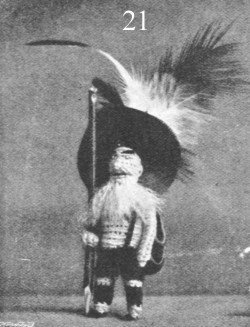
We also get a view of "Wurzl Sepp," who, next to the Kaiser and Bismarck, is the best-known man in Germany. He is a queer old fellow, a hermit, in short, who runs an illicit still among the mountains, and who may frequently be seen in this most picturesque costume (21). A short time ago he was seen at the Berlin Exhibition.
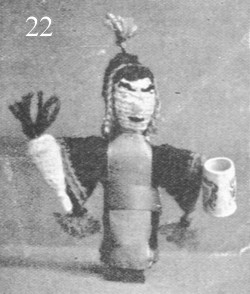 Lastly
comes a little beer-marker in a long
robe and hood,
with a radish in one hand and a beer-mug in the other (22). We have
already seen
him on the top of the Löwenbräu mug (1). He is called the Münchener
Kindl,
or "Munich child." By some mysterious chain of events, in the olden
time the arms of Munich became a little monk, or Mönchen, from
which we
get the German München, or Munich. Now, the little monk always
held a
Bible in one of his hands, and raised the other in exhortation. But in
the Löwenbräu
Keller, we find him with the radish and the beer-mug. The radish, it
may be
added, is an indispensable accompaniment to a mug of beer. It is cut
lengthwise
in long, thin strips. It is then opened like a book, and each leaf is
sprinkled
with salt and then closed again. In a few minutes it is taken up in the
fist and
well squeezed, when the water runs out of it in streams, like the juice
of a
lemon, the flesh becomes soft and flabby, and the radish is ready to be
eaten.
It lies on the table beside the drinkers, and with it the bock becomes
nectar.
So much for the radish in the hand of the little monk.
Lastly
comes a little beer-marker in a long
robe and hood,
with a radish in one hand and a beer-mug in the other (22). We have
already seen
him on the top of the Löwenbräu mug (1). He is called the Münchener
Kindl,
or "Munich child." By some mysterious chain of events, in the olden
time the arms of Munich became a little monk, or Mönchen, from
which we
get the German München, or Munich. Now, the little monk always
held a
Bible in one of his hands, and raised the other in exhortation. But in
the Löwenbräu
Keller, we find him with the radish and the beer-mug. The radish, it
may be
added, is an indispensable accompaniment to a mug of beer. It is cut
lengthwise
in long, thin strips. It is then opened like a book, and each leaf is
sprinkled
with salt and then closed again. In a few minutes it is taken up in the
fist and
well squeezed, when the water runs out of it in streams, like the juice
of a
lemon, the flesh becomes soft and flabby, and the radish is ready to be
eaten.
It lies on the table beside the drinkers, and with it the bock becomes
nectar.
So much for the radish in the hand of the little monk.